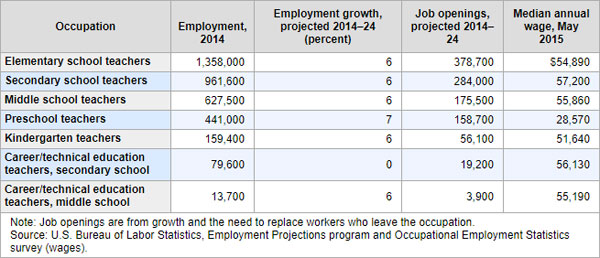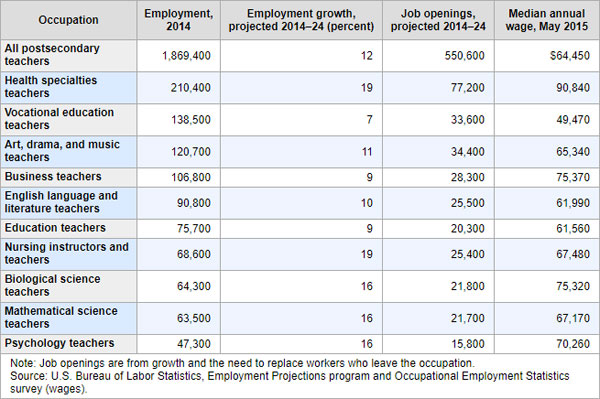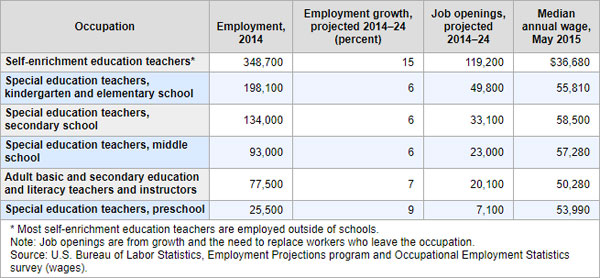
Opportunities for careers in Education include Teaching, Curriculum Development, School Psychology/Testing, Counseling, Administration, Technology, Textbook Publishing, and Research.
Teaching is a wide-ranging field -- from age of the student (infancy to adulthood) -- to the abilities of the student -- and the subject areas of instruction.
If you dream of inspiring the minds of the future, consider teaching. Across all education levels, teachers engage students in learning. Teachers give students the knowledge and tools to succeed both in school and beyond the classroom.
A career in teaching is also projected to have many job opportunities in the coming years. Between 2014 and 2024, the U.S. Bureau of Labor Statistics (BLS) projects nearly 1.9 million job openings for teachers of preschool through postsecondary school.
Keep reading to learn more about teaching opportunities in schools. Find out what it involves, how jobs vary by grade level or specialty, what it takes to become a teacher, and more.
To learn more about specific careers in the field of Education, click on the links below.
More informational content follows the link list.
Careers in Teaching
For many teachers, the workday starts early and ends late. Job duties vary by subject and grade level, among other factors. But teaching generally involves class preparation, instruction time, and after-school duties.
Class preparation. Teachers spend a lot of time preparing for their students. This may include both setting up a classroom prior to the start of the academic year and readying lessons and assignments they plan to cover each day.
Among teachers who have their own classroom, many use visual devices and seating arrangements to create an inviting learning space. For example, they may put up maps, change decorations with the seasons, and display inspirational quotes. Or they may arrange desks in groups or a semicircle to encourage participation.
Preparation for day-to-day teaching may take place inside or outside the classroom. In advance of each day’s lesson, teachers review the topics they plan to cover; write or adjust a lesson plan; and create tests, homework, or other assignments. Improvising in the classroom isn’t a good idea. “Being prepared is crucial and sets a good tone for the class,” Shelly says. “If you go in without a plan, your students will sense it.”
Lesson plans often follow a curriculum. In postsecondary schools (such as colleges and universities), the curriculum takes the form of a course syllabus developed with input from the department. In elementary, middle, and high schools, the curriculum may be set by the state, school district, department, or special mandate (such as a charter).
The curriculum lays out broad learning goals and standards, helping teachers figure out how much time to spend on each topic. Lesson plans break up these goals into smaller, specific pieces that allow for focused instruction—with some leeway. “We have to follow the curriculum to keep up with the goals,” says Adrienne Davenport, a preschool teacher in Portland, Oregon. “But every day is different, and we try to balance learning with fun.”
Instruction time. Teachers often start class by introducing the lesson. To help students understand the lesson better, the introduction might cover terminology, offer context, and show how the topic relates to others. Teachers might use visual aids to summarize the lesson and announce assignments and upcoming tests.
Some teachers are with the same class all day; others have a few classes throughout the day with different students. Class sizes vary by grade level and subject, too. Teachers may have an assistant to help lead daily activities, small groups, or labs.
Providing instruction also involves using strategies to manage the classroom. Teachers may try to structure activities to keep everyone focused, for example. “If it’s just lectures, class is boring,” Shelly says. “Including group activities, moving around, and using the board to visualize the concepts lets students feel successful in their own way, so they stay engaged.”
Teachers routinely assess student progress and may offer extra help to students who fall behind. Homework, tests, and informal assessments give teachers a sense of how well students are learning the curriculum.
After-school duties. Teachers often continue working after the final bell rings. For example, they might sponsor student clubs, chaperone events, or grade assignments.
Before or after class, teachers may have office hours to help individual students, discuss an assignment, and offer advice. They also attend a lot of meetings: with other staff, with school officials, and with parents to discuss student progress or share tips and materials. Teachers also keep in touch with parents and students over the phone, online, or by email.
Some teachers may take on additional responsibilities outside school, acting as consultants or participating in professional organizations. “Becoming involved in these organizations has made me a better teacher and leader,” says Kenneth Huff, a middle school science teacher in Williamsville, New York. “You can learn a lot with the help of others who do what you do.”
By the numbers
BLS data show variation in employment and projected growth in teaching occupations. Wages also differ, based on factors such as grade level and geographic location. For example, in May 2015, postsecondary teachers earned about $10,000 more per year than elementary school teachers ($64,450 compared with $54,890). And teachers in Alaska generally had higher wages overall than those in Montana. But nearly every teaching occupation earned more than the $36,200 median annual wage for all occupations in May 2015.
This section presents data breakdowns by grade level: preschool and kindergarten through high school (K-12) teachers, postsecondary teachers, and special education and other teachers.
Preschool and K-12 teachers. Employment of teaching occupations in preschools and kindergartens and elementary, middle, and high schools totaled about 3.6 million workers in 2014, according to BLS. As table 1 shows, the biggest occupation was elementary school teachers, which accounted for about 37 percent of employment in this group. BLS expects most of these occupations to have average employment growth between 2014 and 2024.
Table 1: Employment, projected outlook, and wages for
preschool and K-12 teachers (except special education)
But employment growth tells only part of the story: Some occupations are expected to have many job openings because of the need to replace teachers who retire or leave for other reasons. And often, the larger the occupation, the greater the number of needed replacements projected. For example, job openings for elementary school teachers are projected to number close to 380,000, many more than the 3,900 openings projected for middle school teachers of career and technical education.
How much these teachers earn varies by occupation. Annual wages were highest in this group for secondary school teachers at $57,200. (Secondary schools are also commonly known as high schools.) Other K-12 teachers earned wages in the $50,000 range, with the exception of preschool teachers—who earned about half that amount ($28,570).
Postsecondary teachers. Postsecondary teachers (commonly referred to as professors or instructors) work in community colleges, universities, technical and trade schools, and other institutions of higher learning. They instruct students in a variety of disciplines, including business, engineering, and music. BLS data show there were nearly 1.9 million postsecondary teachers employed in 2014. (See table 2.) Overall, these occupations are projected to have faster than average employment growth and more than half a million job openings—and over half of these openings are expected to come from the need to replace teachers who leave.
Table 2: Employment, projected outlook, and
wages for selected postsecondary teachers
Because there are so many types of postsecondary teacher occupations, table 2 shows those with the most employment. Projected job growth varies by occupation. For example, BLS projects faster than average employment growth (19 percent) between 2014 and 2024 for both health specialties teachers—the largest postsecondary teacher occupation—and nursing instructors and teachers. By comparison, employment of vocational education teachers, which also had high employment, is expected to have average growth (7 percent).
Health specialties teachers also had the highest median annual wage of the occupations in the table at $90, 840. Wages for all of the occupations shown in the table were higher than the median for all workers. Vocational education teachers had the lowest annual wage ($49,470) of all postsecondary teachers; law professors, not shown in the table, earned the highest annual wage ($105,250).
Special education and other teachers. There are other opportunities available for schoolteachers. Special education and other teachers work with students who have special needs, who want remedial help, or who need literacy instruction.
According to BLS, there were 876,800 special education and other teachers in 2014. As table 3 shows, self-enrichment teachers had the highest employment (although most of this was outside schools, because they teach self-improvement and nonacademic subjects), projected growth, and projected job openings—but also had the lowest wage. BLS prepares employment data that separate special education teachers by grade level, but all grades combined show these teachers accounted for about half of all employment.
Table 3: Employment, projected outlook, and
wages for special education and other teachers
All but one of the teaching occupations in this table had median annual wages over $50,000 in May 2015. Self-enrichment teachers, who earned $36,680, were the exception.
Ups and downs
Teaching can be both gratifying and draining. You’ll spend a lot of time dealing with students and staff. Each day may bring a series of rewards and challenges, so it’s helpful to be aware of what to expect if you become a teacher.
Rewards. For many teachers, helping students learn is the best part of the job. Teachers say they like sharing their passion for a subject matter and watching students’ reactions when they grasp a concept. “I love seeing my students grow and the excitement in their eyes when they’re learning,” Davenport says.
Teachers also enjoy getting to know their students. They may develop a bond with some students and continue to support them through the years. It’s rewarding for a teacher when these students consider him or her not just an educator, but also a mentor, a role model—and, in adulthood, a friend.
And teachers say they enjoy working with people who value education as much as they do. Teachers often become a support network for each other, sharing materials, camaraderie, and advice. “Try to get feedback from as many teachers as you can,” says Mieke Cranford, a high school English teacher in Alexandria, Virginia. “Everyone does things differently, and you can learn something from all of them.”
Another highlight of teaching, educators say, is that the diversity of lessons mean that every class is different and no two days are alike. In many schools, the academic year lasts 10 months, allowing teachers time to travel, relax, or earn additional income during their breaks.
Challenges. Teachers say that classroom management is one of their biggest challenges. Keeping students interested and engaged in a lesson requires a lot of energy, especially when students have varied learning styles and absorb the material at different rates. Keeping the classroom under control can be stressful for teachers when bored or discouraged students disrupt lessons.
Long hours are another drawback to teaching. Teachers often arrive at school early and leave long after students are gone. Their workload sometimes requires spending time outside of school to grade assignments, prepare materials, and complete student assessments or other paperwork.
Teachers also may get frustrated with federal, state, or local oversight that affects schools. For example, education standards that use test scores to measure student performance may limit how much time teachers spend on a topic. And budget cuts to school funding may result in decreased program offerings, increased class sizes, and other setbacks. Teachers say such actions put the burden on them to maintain the same quality of education with fewer resources.
Becoming a teacher
Before leading your own classroom, you’ll have to learn to be a teacher. You need skills, education, and other qualifications to be eligible for employment in teaching occupations.
Skills. Communication skills, both written and oral, are critical for teachers. At all education levels, teachers must be able to express information in a clear and engaging manner and to listen and respond to students’ questions. They also write reports, give feedback on assignments, and interact with many types of people—including parents, colleagues, and students.
Empathy, resourcefulness, and patience help teachers to engage students at a personal level and to find learning strategies that fit individual abilities. To “hook” students into a lesson, for example, teachers may use different educational tools. “They don’t have to learn everything from me,” says Shelly. “I might show a video that explains a concept or skill, expand on the topic through additional instruction, then reinforce the learning with a game.”
Organizational skills are also important. Teachers juggle many moving parts every day: lesson plans, assignments and tests, and meeting times, to name a few. Meticulous recordkeeping, such as creating a spreadsheet, helps teachers stay on track.
Education. Education requirements for new teachers vary by occupation. Two teaching occupations usually need less than a bachelor’s degree for entry: self-enrichment teachers (high school diploma) and preschool teachers (associate’s degree). All other teaching occupations typically need at least a bachelor’s degree, with postsecondary teachers usually requiring a master’s or doctoral degree.
K-12 teachers in most states usually need a bachelor’s degree. Prospective teachers take education courses to learn different instructional techniques and communication styles appropriate to their students’ level. For example, education majors planning to teach kindergarten and elementary school may need to take a course in child psychology.
Other qualifications. To work in public schools, teachers usually need certification or a license. This may mean completing a teacher education program and passing tests that demonstrate subject-matter and instructional knowledge.
Teacher education programs prepare teaching candidates to work in the occupation. These programs often include internships—commonly known as student teaching—that require teacher candidates to work with a mentor teacher and gain experience in the classroom.
Most states also require teachers to pass a background check and to complete continuing education classes or seminars in order to maintain their certification or license. National Board Certification is a voluntary credentialing option that may allow teachers to bypass continuing education in some states, but it does not replace each state’s individual requirements. Some states have alternative teacher certification or reciprocity agreements with other states to encourage people to enter or continue in the occupation.
No matter how they get their credentials, many teachers say they make a career of it for the chance to make a difference. “I love teaching for a lot of reasons,” says Shelly. “Wanting my students to have more access to opportunities in life is what keeps pushing me.”
For more information
The U.S. Department of Education has a variety of teacher resources, such as lesson plans, FAQs, and recommendations for improving classroom performance.
Teacher associations, such as the National Education Association and the Association of American Educators, offer career resources, scholarships, lesson plans, and more. To learn more about a specific type of teacher occupation, visit any of the following organizations
- American Association of University Professors
- National Association of Independent Schools
- National Association of Special Education Teachers
- National Council of Teachers of English
- National Council of Teachers of Mathematics
- National Science Teachers Association
If you’re interested in working in underserved areas, you may have additional options
- The Teacher Loan Forgiveness Program allows for cancellation of up to $17,500 in federal student loans if you teach for 5 years in a low-income community. Visit TEACH or contact one of your state’s education agencies for more information.
- Teach for America is a nonprofit organization that works to improve educational opportunities in low-income communities by offering an alternative path to teaching.
citation - Dennis Vilorio, "Teaching for a living," Career Outlook, U.S. Bureau of Labor Statistics.
_____
Elementary School / Middle School / High School - Careers List
- 1st Grade Teacher
- 2nd Grade Teacher
- 3rd Grade Teacher
- 4th Grade Teacher
- 5th Grade Teacher
- 6th Grade Teacher
- 7th Grade Teacher
- 8th Grade Teacher
- 9th Grade Teacher
- 10th Grade Teacher
- 11th Grade Teacher
- 12th Grade Teacher
- Teacher Assistant
- Administration
- Advanced Placement
- Alternative Placement
- Art
- Athletic Coaching
- Biology
- Business
- Career & Technical
- Chemistry
- Counselor
- Dance
- Drama
- Debate
- Early Childhood
- Earth Science
- Economics
- Engineering
- ESL/ELL/Bilingual
- Foreign Language
- Geography
- Gifted and Talented
- History/ Social Studies
- Home Economics/Consumer Science
- Homeroom
- Industrial Arts
- Kindergarten
- Language Arts/English
- Library Media Specialist
- Mathematics
- Music/Band/Orchestra
- Physical/Health Education
- Physics
- Political Sci./Am. Govt.
- Reading Specialist
- Resource Teacher
- Science
- Social Studies/ History
- Technology
- Theater
- Vocational
Special Education Careers List
- Adaptive Physical Education
- Administration
- Alternative Placement
- Audiologist
- Behavior Specialist
- Dev. Special Instruction
- Early Childhood Spec. Ed.
- Gifted / Talented
- Hearing Impaired
- Occ. Therapists/Assistants
- Phys. Therapists/Assistants
- School Psychologist
- Sign Language Interpreter
- Speech Language Pathology/Assistants
- Spec. Ed. Teacher (Elem.)
- Spec. Ed. Teacher (H.S.)
- Spec. Ed. Teacher (M.S.)
- Special Education Coordinator
- Special Education Director
- Teacher Assistant/ Paraprofessional Spec. Ed.
- Vision Impaired
Staff Positions
- Bus Driver/ Monitor
- Business/Office Manager
- Campus Monitor/ Security
- Custodial
- Dance
- Food Service
- Health Office Aide
- Instructional Assistant/Paraprofessional
- Maintenance
- Parent/Family Liaison
- Registrar/Enrollment
- School Crossing Guard
- Secretary/Administrative Assistant
Other Education/Administration/Teaching Positions
- Academic Coach
- Adult Education
- Department of Education Staff
- Athletic Director
- Early Intervention
- Before/After School Programs
- Dean of Students
- Director
- Higher Education
- Homebound Teacher
- Human Resource Specialist/ Assistant
- IT Support
- Mentor and Volunteer
- Principal/Assistant Principal
- Public Relations
- School District Level
- School Nurse
- Secure Care
- Security Officer
- Social Worker
- Substitute Teacher
- Summer Programs
- Superintendent/ Assistant Superintendent
- Test Administrator/ Coordinator
- Transportation Director/ Supervisor






 School Librarian / School Media Specialist
School Librarian / School Media Specialist